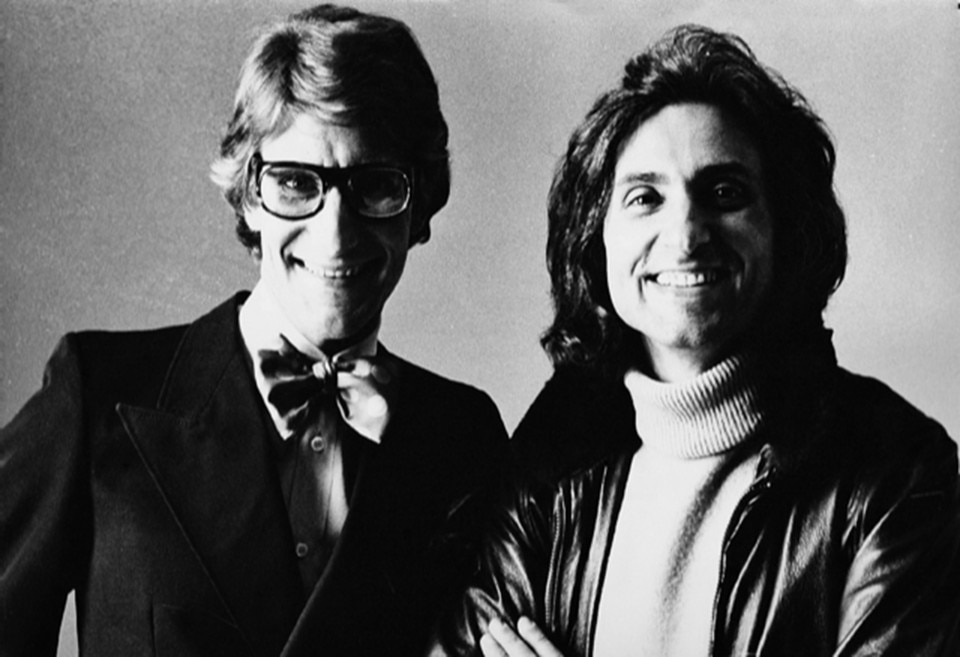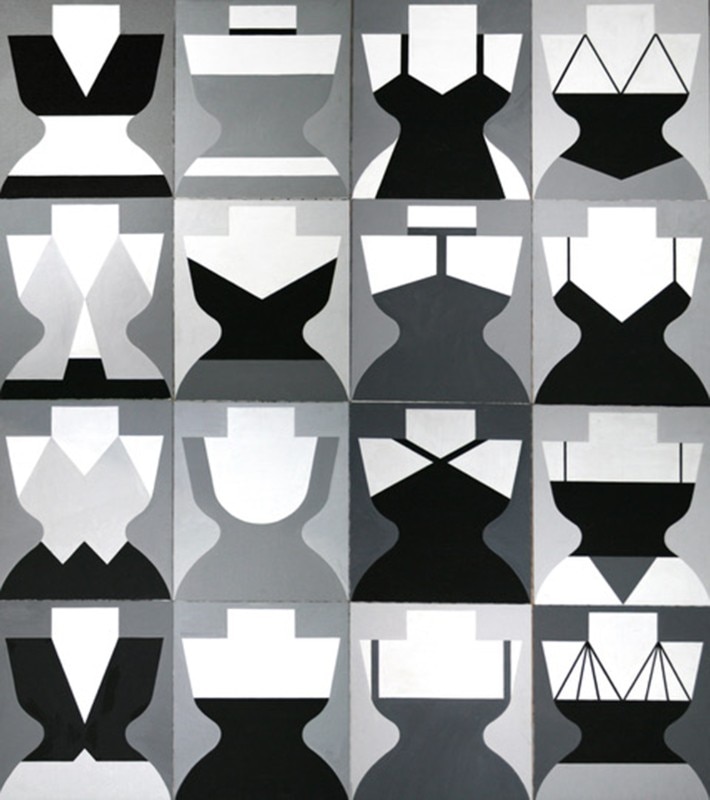“I had the great good fortune to work with, and so learn from, Flavio Lucchini. He was the man behind the promotion of fashion and design across the world – the real innovator and creator of Italian manufacturing, which developed as a result of his work and the impetus provided by the publications of the time.”
This is Oliviero Toscani’s description of Flavio Lucchini, art director, sophisticated artist and creator of the most important Italian fashion titles. A leading figure and forerunner of the specialised publishing culture of the 1960s, 70s and 80s, Lucchini, now 90, divides his time between Milan, where he has his studio, and Paris, where in his Saint-Germain home-gallery he focuses completely on his art.
To mark his 90th birthday, the gallery MyOwnGalleryat Superstudio has put on an exhibition in his honour (until 31 December), with 90 of his most representative works. On 27 October, Milan Triennale is hosting “Ricomincio da 90”, a soiree event presenting a video narration and an autobiography with images and memories of the heyday of Italian fashion – of which he was indisputably a leading figure and profound innovator.
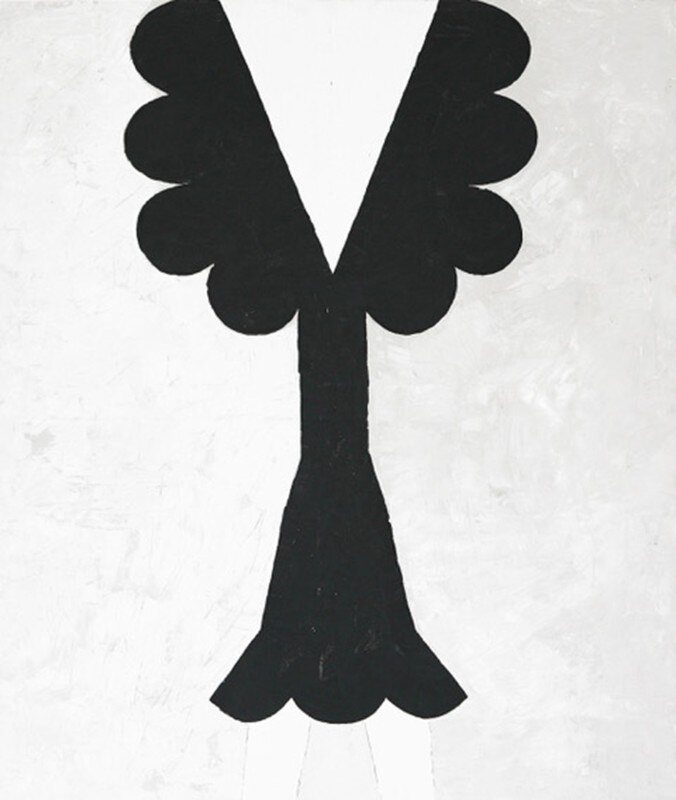
You were one of the most influential figures in fashion publishing in the 1970s, 80s and 90s. How did you discover your vocation for fashion?
As Giorgio Armani said, I wasn’t born with a vocation for fashion, unlike many people, who are destined for it from very young. I was good at drawing at primary school. At my secondary school, which specialised in science, I really wanted to become an artist. At that time, around 1944, I’d discovered the Impressionists, the Cubists, the Futurists, the Surrealists, and others. I liked Matisse and Picasso most of all.
What memories do you have of getting started?
Mantua and the world of science no longer suited me. I did my final school art exams in Brera, and I fell in love with graphic design. The Swiss style invented by Helvetica was in fashion. Milan seemed to me a city on the verge of a rebirth, with extraordinary individuals and fascinating architecture, but I was still living in Mantua. I enrolled at the Architecture Faculty in Venice, where I discovered, alongside Zevi, Gardella and Scarpa, pioneers of modern architecture such as Le Corbusier, Gropius, Aalto, Frank Lloyd Wright, and others.
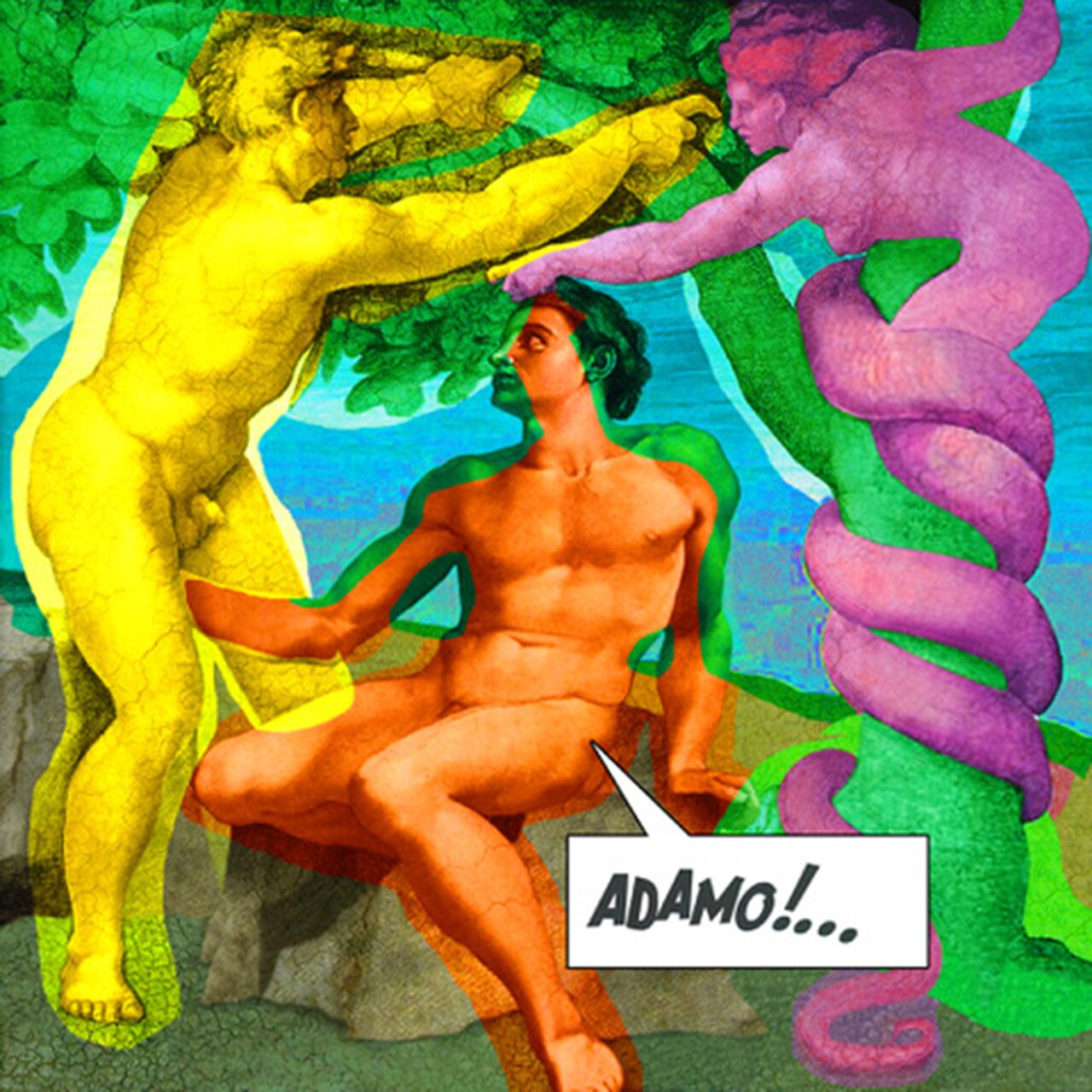
 View gallery
View gallery
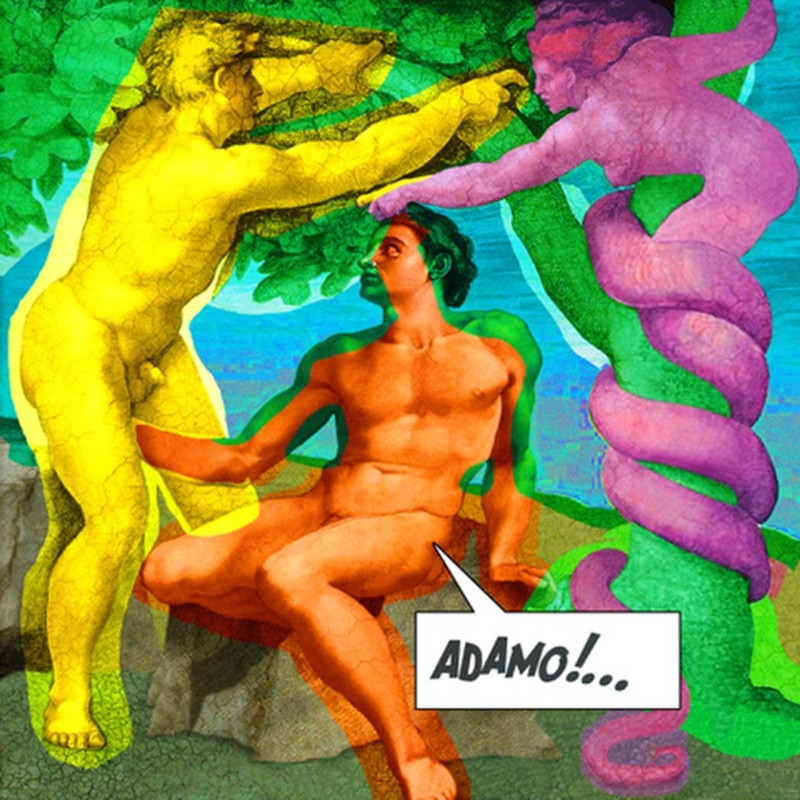
Flavio Lucchini: artworks
A review of the artist's work, a multifaceted mind that, ranging from publishing to architecture, not forgetting about art and graphics, his great passion, is a supporter of Made in Italy.
Flavio Lucchini, Adamo!, digital painting on canvas, cm 50x50, 201.
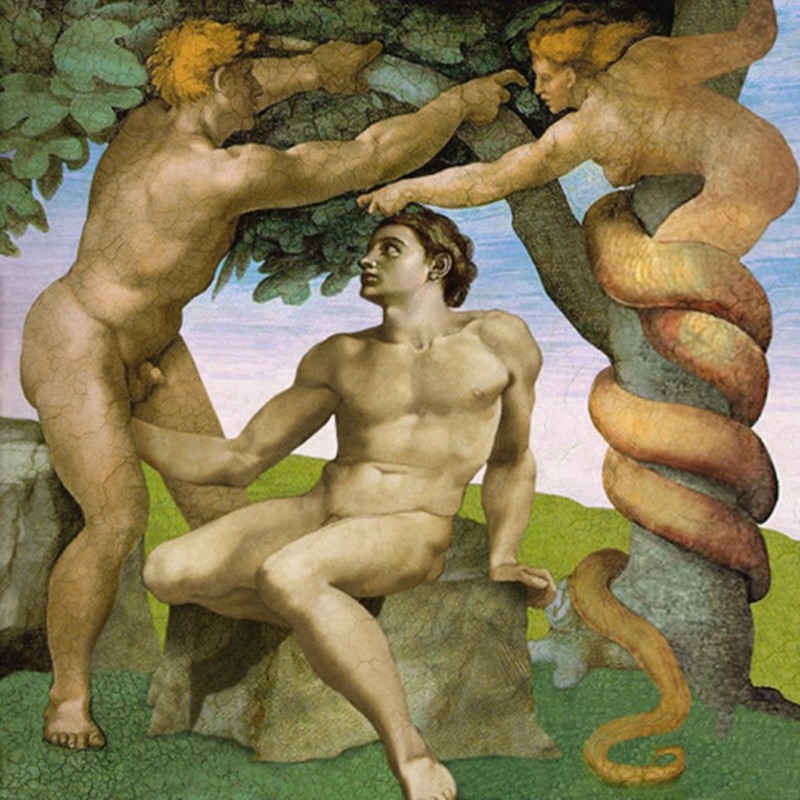
Flavio Lucchini: artworks
A review of the artist's work, a multifaceted mind that, ranging from publishing to architecture, not forgetting about art and graphics, his great passion, is a supporter of Made in Italy.
Flavio Lucchini, Adamo!, digital painting on canvas, cm 140,5x140,5. 2010
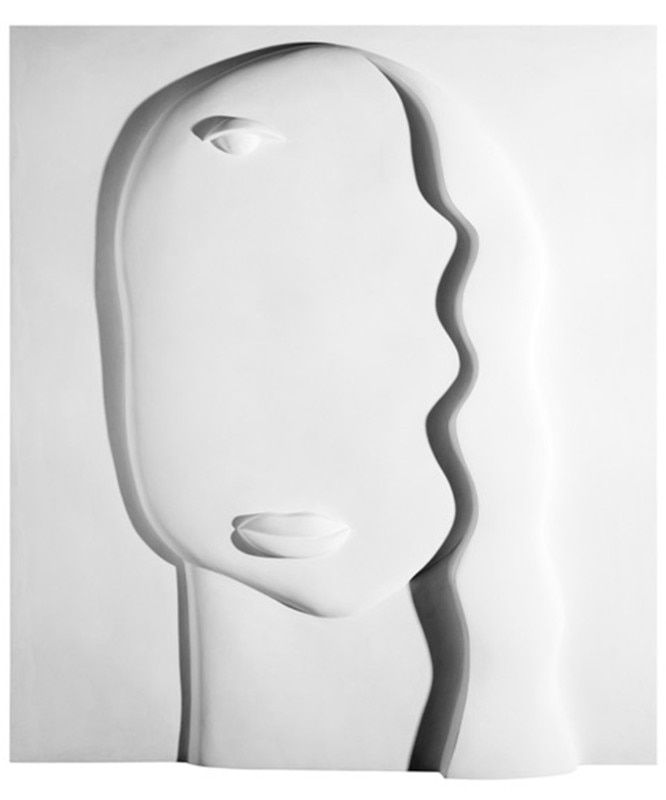
Flavio Lucchini: artworks
A review of the artist's work, a multifaceted mind that, ranging from publishing to architecture, not forgetting about art and graphics, his great passion, is a supporter of Made in Italy.
Flavio Lucchini, Faces. I am different, Buzz bas-relief, 2006.
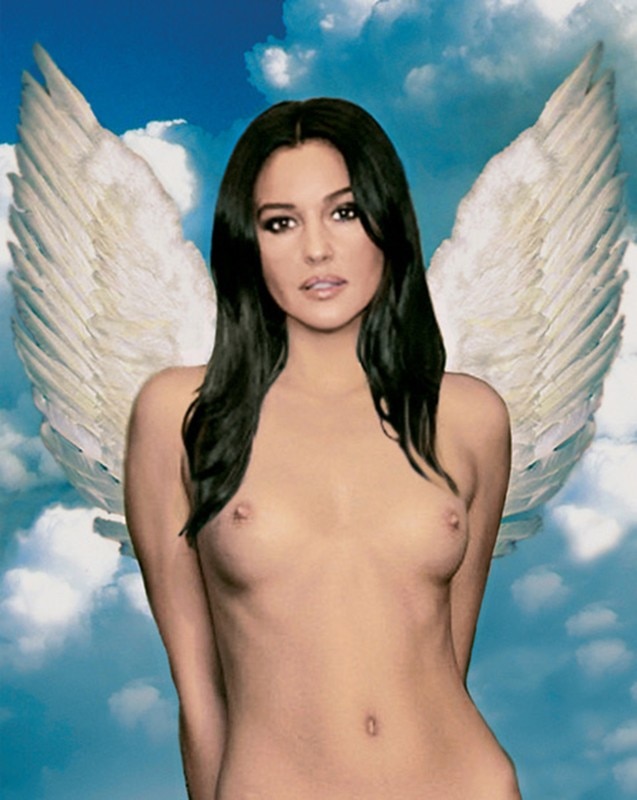
Flavio Lucchini: artworks
A review of the artist's work, a multifaceted mind that, ranging from publishing to architecture, not forgetting about art and graphics, his great passion, is a supporter of Made in Italy.
Flavio Lucchini, My Angel, digital painting on canvas, 2008. 152x224 cm
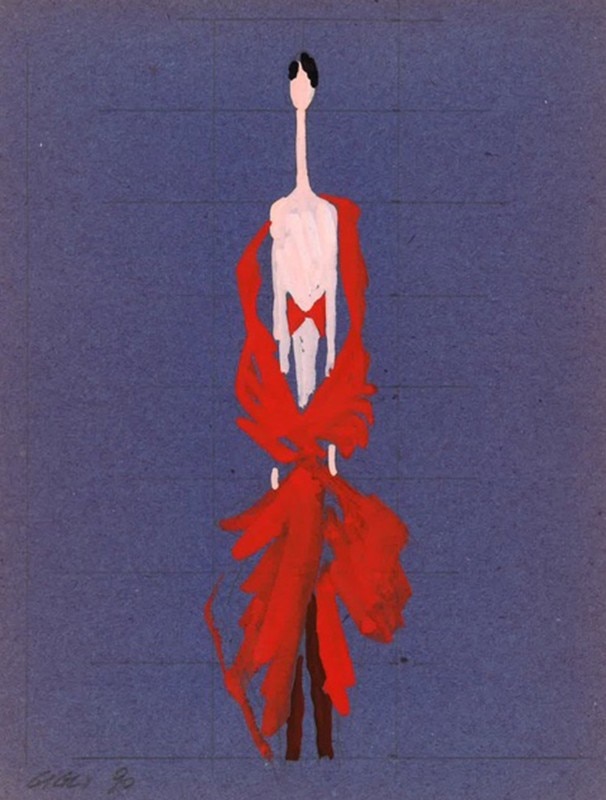
Flavio Lucchini: artworks
A review of the artist's work, a multifaceted mind that, ranging from publishing to architecture, not forgetting about art and graphics, his great passion, is a supporter of Made in Italy.
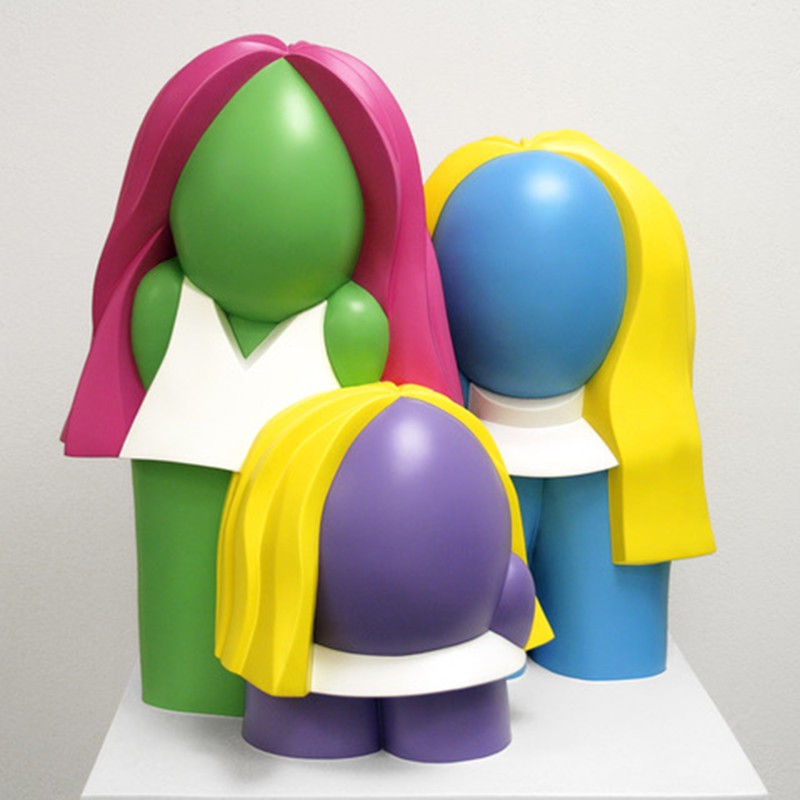
Flavio Lucchini: artworks
A review of the artist's work, a multifaceted mind that, ranging from publishing to architecture, not forgetting about art and graphics, his great passion, is a supporter of Made in Italy.
Flavio Lucchini, Dolls n.34, resin sculpture and acrylic colours, 2007.
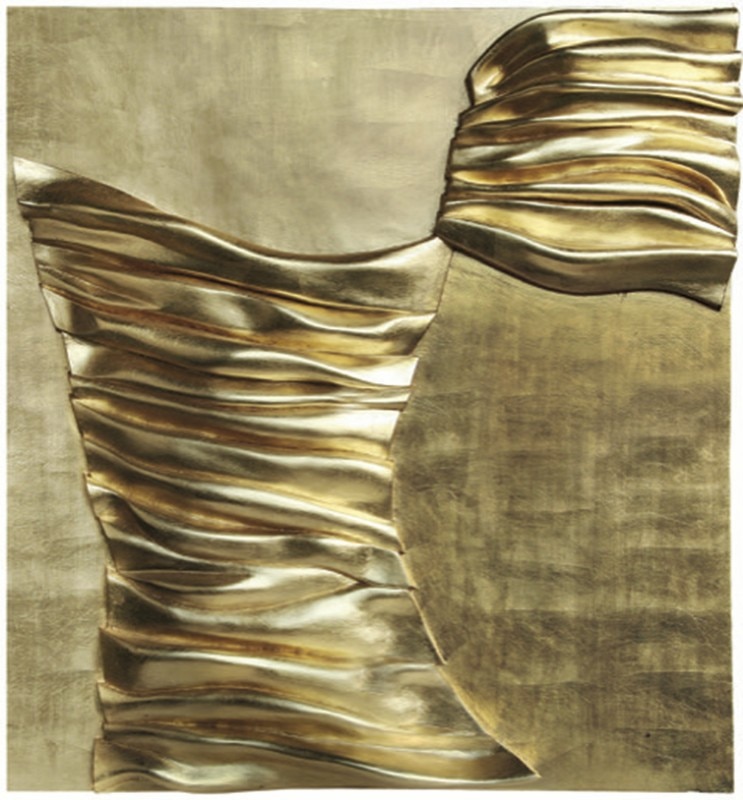
Flavio Lucchini: artworks
A review of the artist's work, a multifaceted mind that, ranging from publishing to architecture, not forgetting about art and graphics, his great passion, is a supporter of Made in Italy.
Flavio Lucchini, Dress Gold, Reinforced chalk and gold foil sculpture.
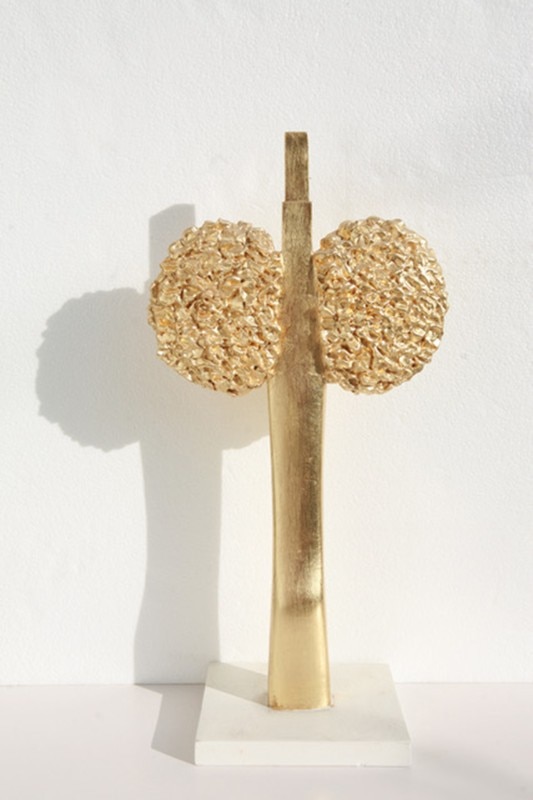
Flavio Lucchini: artworks
A review of the artist's work, a multifaceted mind that, ranging from publishing to architecture, not forgetting about art and graphics, his great passion, is a supporter of Made in Italy.
Flavio Lucchini, Balloon sleeves dress, chalk and gold foil maquette, 2001.
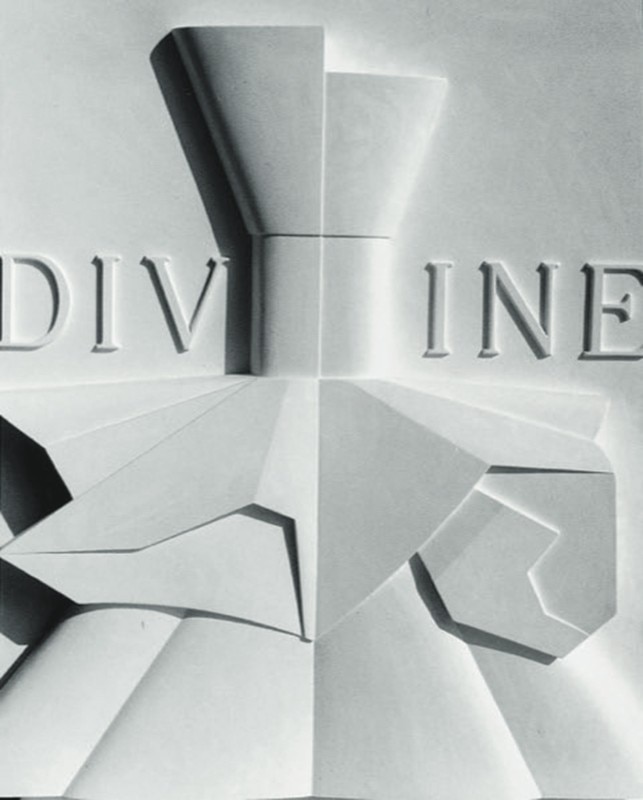
Flavio Lucchini: artworks
A review of the artist's work, a multifaceted mind that, ranging from publishing to architecture, not forgetting about art and graphics, his great passion, is a supporter of Made in Italy.
Flavio Lucchini, Divine-Reperto-fashion n.34, resin and fiber bas-relief, 2003. cm 60x70
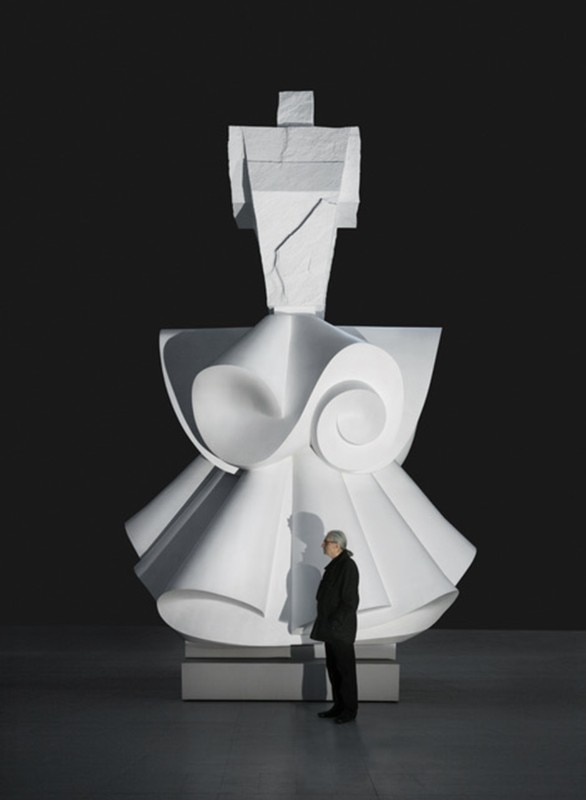
Flavio Lucchini: artworks
A review of the artist's work, a multifaceted mind that, ranging from publishing to architecture, not forgetting about art and graphics, his great passion, is a supporter of Made in Italy.
Flavio Lucchini, Gran Sera n.2, giant fiber and resin totem, cutted stone bodice, baroque swirls skirt, opaque white acrylic, 2000.
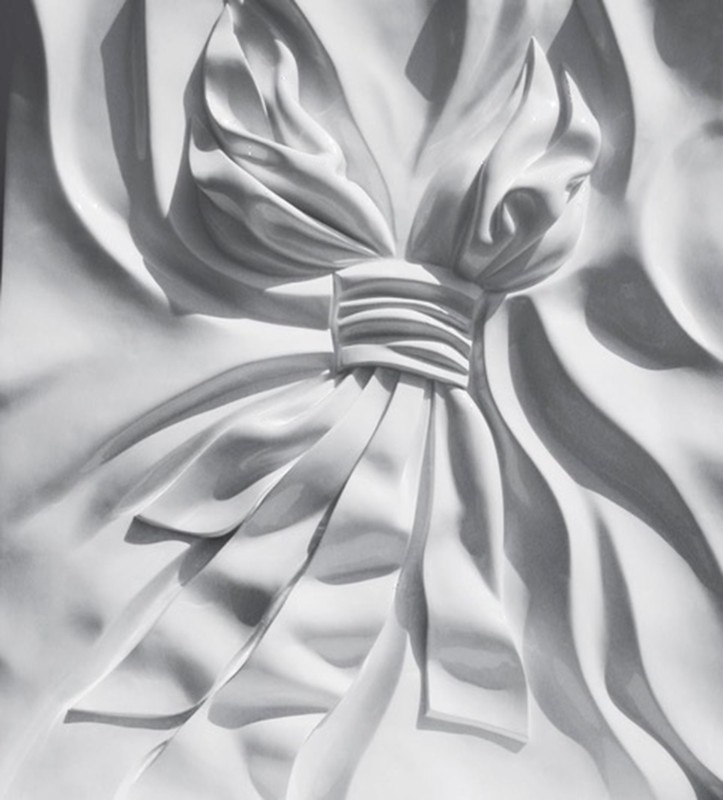
Flavio Lucchini: artworks
A review of the artist's work, a multifaceted mind that, ranging from publishing to architecture, not forgetting about art and graphics, his great passion, is a supporter of Made in Italy.
Flavio Lucchini, Reperto-fashion n.9, resin and fiber bas-relief, 2002.
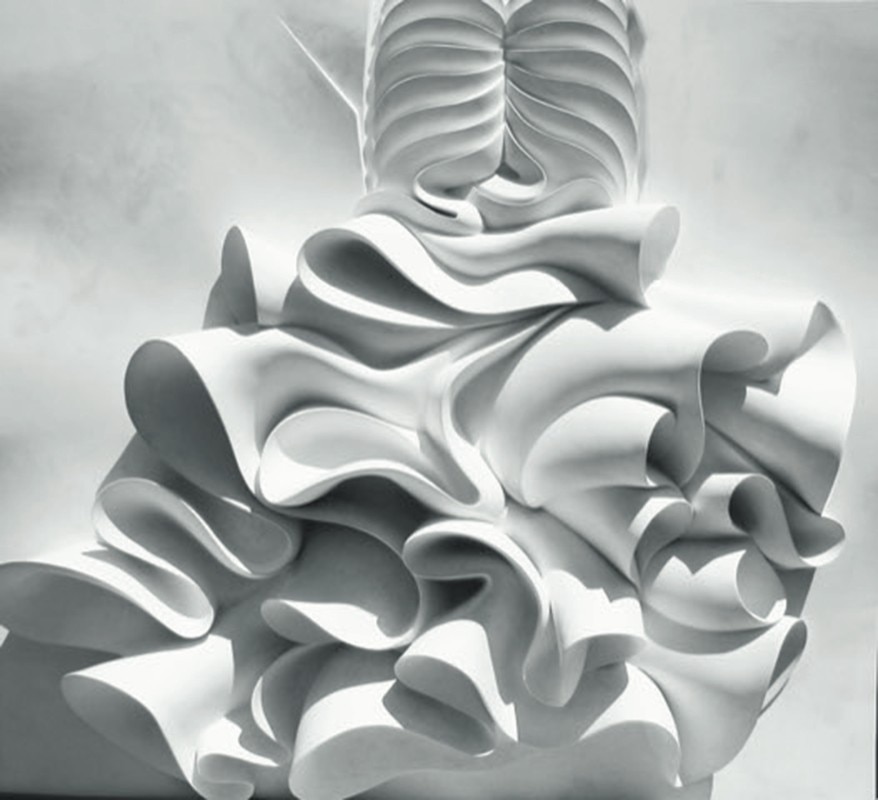
Flavio Lucchini: artworks
A review of the artist's work, a multifaceted mind that, ranging from publishing to architecture, not forgetting about art and graphics, his great passion, is a supporter of Made in Italy.
Flavio Lucchini, Reperto-fashion n.46, chalk bas-relief on wood, 2005.
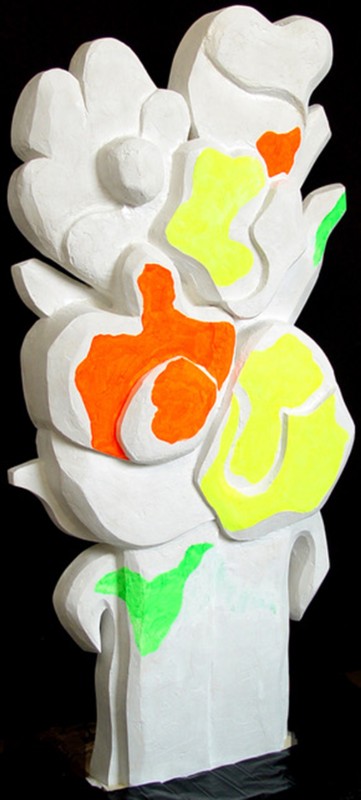
Flavio Lucchini: artworks
A review of the artist's work, a multifaceted mind that, ranging from publishing to architecture, not forgetting about art and graphics, his great passion, is a supporter of Made in Italy.
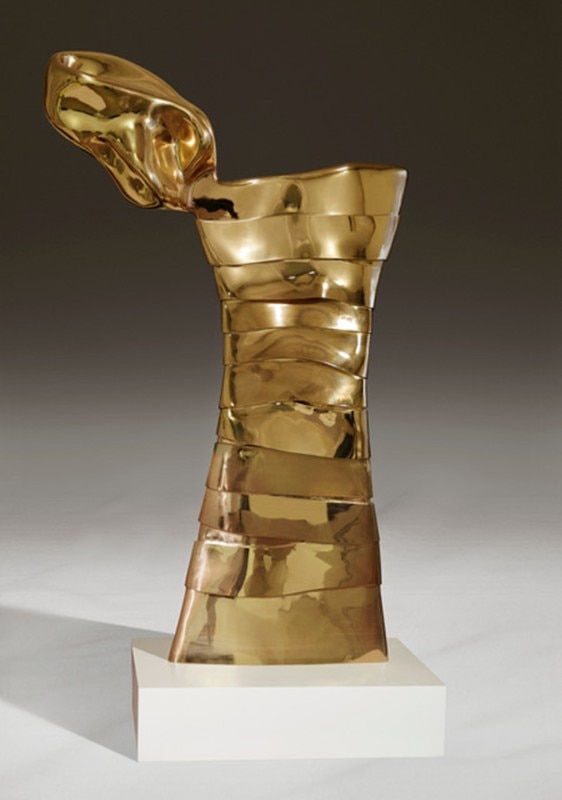
Flavio Lucchini: artworks
A review of the artist's work, a multifaceted mind that, ranging from publishing to architecture, not forgetting about art and graphics, his great passion, is a supporter of Made in Italy.
Flavio Lucchini, Ghost n.5, coppery resin sculpture, 2006.
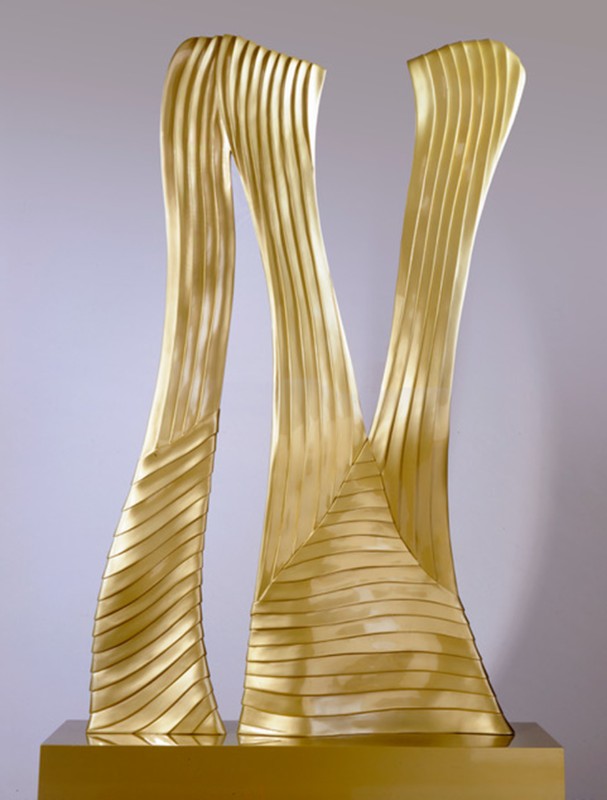
Flavio Lucchini: artworks
A review of the artist's work, a multifaceted mind that, ranging from publishing to architecture, not forgetting about art and graphics, his great passion, is a supporter of Made in Italy.
Flavio Lucchini, Ghost n.3, golden resin sculpture, 2005.
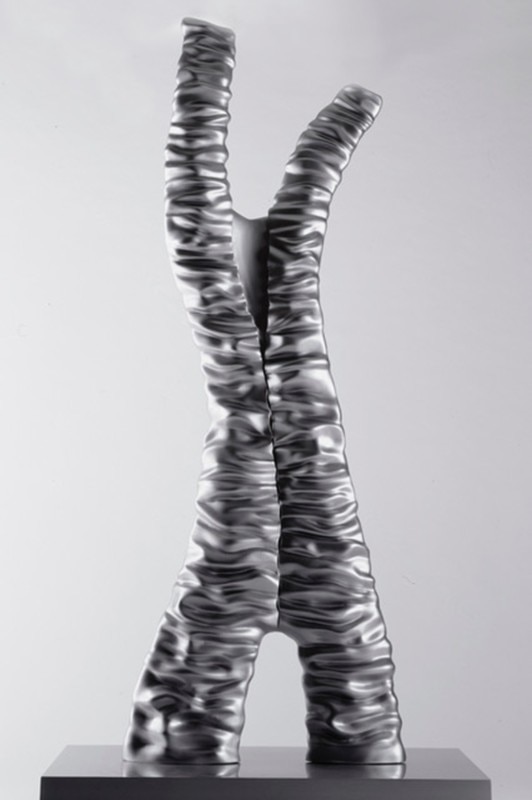
Flavio Lucchini: artworks
A review of the artist's work, a multifaceted mind that, ranging from publishing to architecture, not forgetting about art and graphics, his great passion, is a supporter of Made in Italy.
Flavio Lucchini, Ghost n.2, silver resin sculpture, 2005.
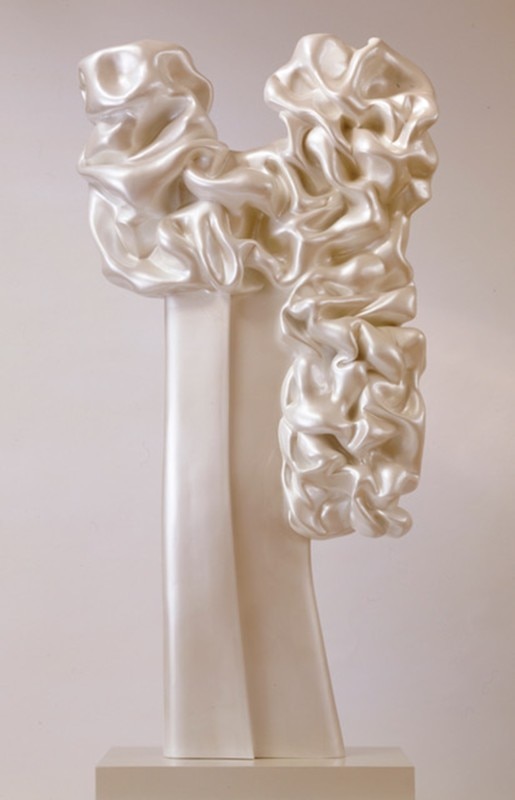
Flavio Lucchini: artworks
A review of the artist's work, a multifaceted mind that, ranging from publishing to architecture, not forgetting about art and graphics, his great passion, is a supporter of Made in Italy.
Flavio Lucchini, Ghost n.4, pearly resin sculpture, 2005.
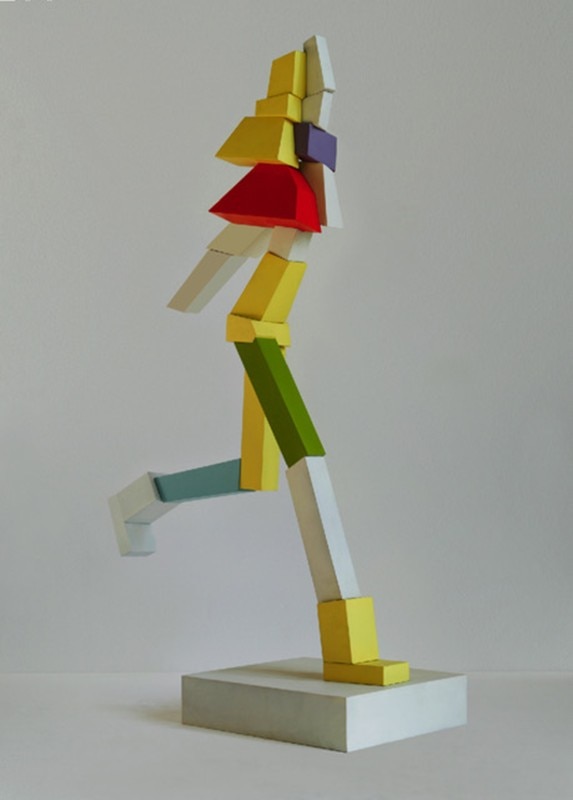
Flavio Lucchini: artworks
A review of the artist's work, a multifaceted mind that, ranging from publishing to architecture, not forgetting about art and graphics, his great passion, is a supporter of Made in Italy.
Flavio Lucchini, Dress-ToysIron, wood, painted steel, cor-ten steel toys-sculptures, for external use too.

Flavio Lucchini: artworks
A review of the artist's work, a multifaceted mind that, ranging from publishing to architecture, not forgetting about art and graphics, his great passion, is a supporter of Made in Italy.
Flavio Lucchini, Adamo!, digital painting on canvas, cm 50x50, 201.

Flavio Lucchini: artworks
A review of the artist's work, a multifaceted mind that, ranging from publishing to architecture, not forgetting about art and graphics, his great passion, is a supporter of Made in Italy.
Flavio Lucchini, Adamo!, digital painting on canvas, cm 140,5x140,5. 2010

Flavio Lucchini: artworks
A review of the artist's work, a multifaceted mind that, ranging from publishing to architecture, not forgetting about art and graphics, his great passion, is a supporter of Made in Italy.
Flavio Lucchini, Faces. I am different, Buzz bas-relief, 2006.

Flavio Lucchini: artworks
A review of the artist's work, a multifaceted mind that, ranging from publishing to architecture, not forgetting about art and graphics, his great passion, is a supporter of Made in Italy.
Flavio Lucchini, My Angel, digital painting on canvas, 2008. 152x224 cm

Flavio Lucchini: artworks
A review of the artist's work, a multifaceted mind that, ranging from publishing to architecture, not forgetting about art and graphics, his great passion, is a supporter of Made in Italy.

Flavio Lucchini: artworks
A review of the artist's work, a multifaceted mind that, ranging from publishing to architecture, not forgetting about art and graphics, his great passion, is a supporter of Made in Italy.
Flavio Lucchini, Dolls n.34, resin sculpture and acrylic colours, 2007.

Flavio Lucchini: artworks
A review of the artist's work, a multifaceted mind that, ranging from publishing to architecture, not forgetting about art and graphics, his great passion, is a supporter of Made in Italy.
Flavio Lucchini, Dress Gold, Reinforced chalk and gold foil sculpture.

Flavio Lucchini: artworks
A review of the artist's work, a multifaceted mind that, ranging from publishing to architecture, not forgetting about art and graphics, his great passion, is a supporter of Made in Italy.
Flavio Lucchini, Balloon sleeves dress, chalk and gold foil maquette, 2001.

Flavio Lucchini: artworks
A review of the artist's work, a multifaceted mind that, ranging from publishing to architecture, not forgetting about art and graphics, his great passion, is a supporter of Made in Italy.
Flavio Lucchini, Divine-Reperto-fashion n.34, resin and fiber bas-relief, 2003. cm 60x70

Flavio Lucchini: artworks
A review of the artist's work, a multifaceted mind that, ranging from publishing to architecture, not forgetting about art and graphics, his great passion, is a supporter of Made in Italy.
Flavio Lucchini, Gran Sera n.2, giant fiber and resin totem, cutted stone bodice, baroque swirls skirt, opaque white acrylic, 2000.

Flavio Lucchini: artworks
A review of the artist's work, a multifaceted mind that, ranging from publishing to architecture, not forgetting about art and graphics, his great passion, is a supporter of Made in Italy.
Flavio Lucchini, Reperto-fashion n.9, resin and fiber bas-relief, 2002.

Flavio Lucchini: artworks
A review of the artist's work, a multifaceted mind that, ranging from publishing to architecture, not forgetting about art and graphics, his great passion, is a supporter of Made in Italy.
Flavio Lucchini, Reperto-fashion n.46, chalk bas-relief on wood, 2005.

Flavio Lucchini: artworks
A review of the artist's work, a multifaceted mind that, ranging from publishing to architecture, not forgetting about art and graphics, his great passion, is a supporter of Made in Italy.

Flavio Lucchini: artworks
A review of the artist's work, a multifaceted mind that, ranging from publishing to architecture, not forgetting about art and graphics, his great passion, is a supporter of Made in Italy.
Flavio Lucchini, Ghost n.5, coppery resin sculpture, 2006.

Flavio Lucchini: artworks
A review of the artist's work, a multifaceted mind that, ranging from publishing to architecture, not forgetting about art and graphics, his great passion, is a supporter of Made in Italy.
Flavio Lucchini, Ghost n.3, golden resin sculpture, 2005.

Flavio Lucchini: artworks
A review of the artist's work, a multifaceted mind that, ranging from publishing to architecture, not forgetting about art and graphics, his great passion, is a supporter of Made in Italy.
Flavio Lucchini, Ghost n.2, silver resin sculpture, 2005.

Flavio Lucchini: artworks
A review of the artist's work, a multifaceted mind that, ranging from publishing to architecture, not forgetting about art and graphics, his great passion, is a supporter of Made in Italy.
Flavio Lucchini, Ghost n.4, pearly resin sculpture, 2005.

Flavio Lucchini: artworks
A review of the artist's work, a multifaceted mind that, ranging from publishing to architecture, not forgetting about art and graphics, his great passion, is a supporter of Made in Italy.
Flavio Lucchini, Dress-ToysIron, wood, painted steel, cor-ten steel toys-sculptures, for external use too.
Your career has been spent in the worlds of publishing, architecture, art and graphic design. What importance did they have in your professional training and why?
They have all been major interests in my life. At the end of the 1950s in Milan, there were no model agencies or photographers specialising in fashion. The weekly magazines then used photographers who generally worked in journalism. I started by getting in touch with Jean-Loup Sieff, Frank Horvat and many other young photographers who were active in Paris. Fashion with them was different.
I remember that the films of the Nouvelle Vague were on at the cinema. There was a new feeling in the air. Then came the Beatles, the miniskirt, Carnaby Street and the King’s Road in London. I became friends with industrialists, fashion designers, fabric makers, photographers and hairdressers, but also with intellectuals such as Francesco Alberoni, Ettore Sottsass and Fernanda Pivano.
You had a particularly close friendship with Sottsass. Do you have any special memories of him?
I remember a dinner we had in my house after our trip to St Petersburg and Moscow – all we ate was caviar. But above all I remember the suppers we had in a little room he reserved in the Hotel Capitol, which used to stand in Via Manzoni. He was just back from Palo Alto, where a clinic had saved his life by using a computer to administer his medicine. He was like an Indian guru [smiles]. He wore sandals with little bells that tinkled when he walked. He was a great man. Everyone loved him for his humanity, intelligence and imagination.
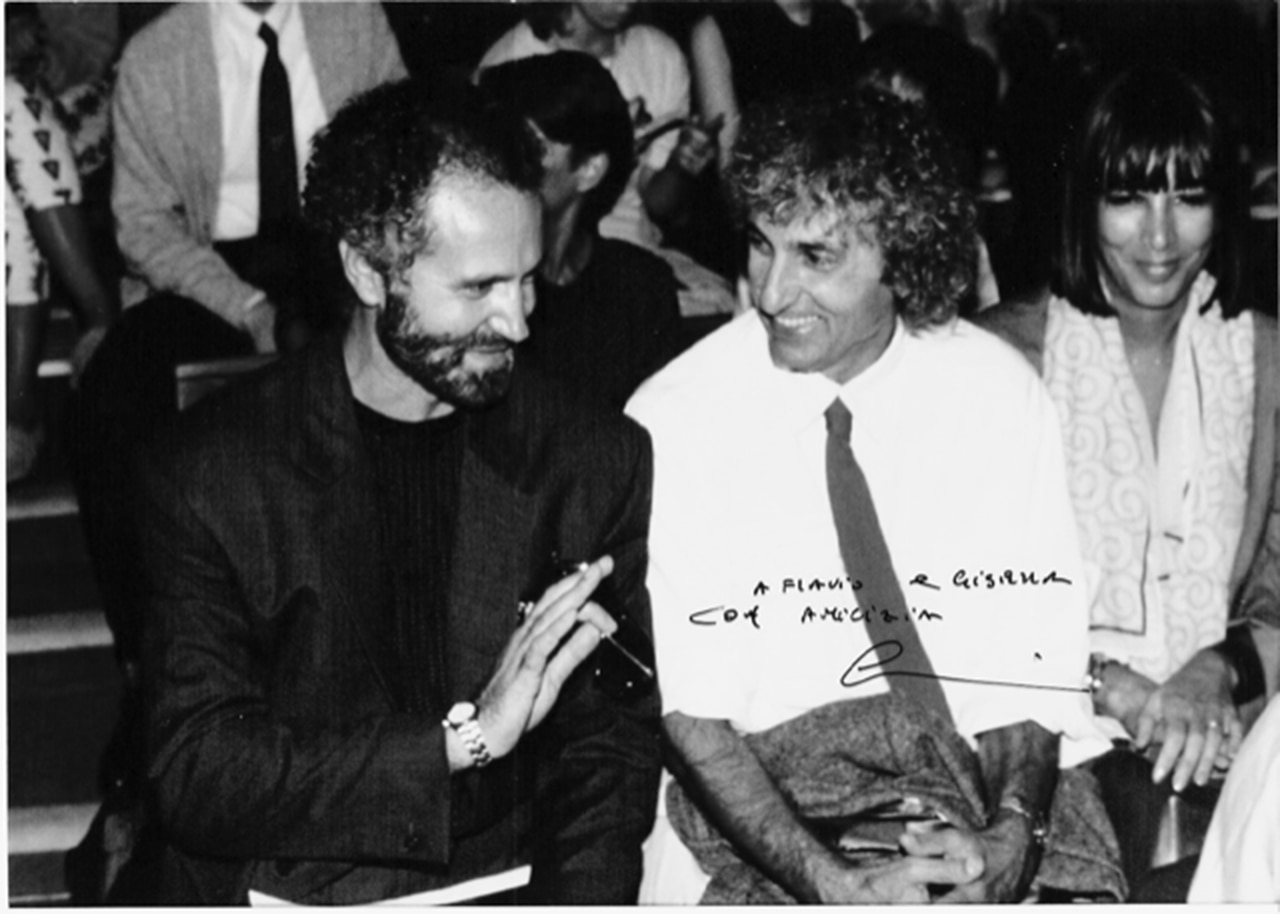
 View gallery
View gallery
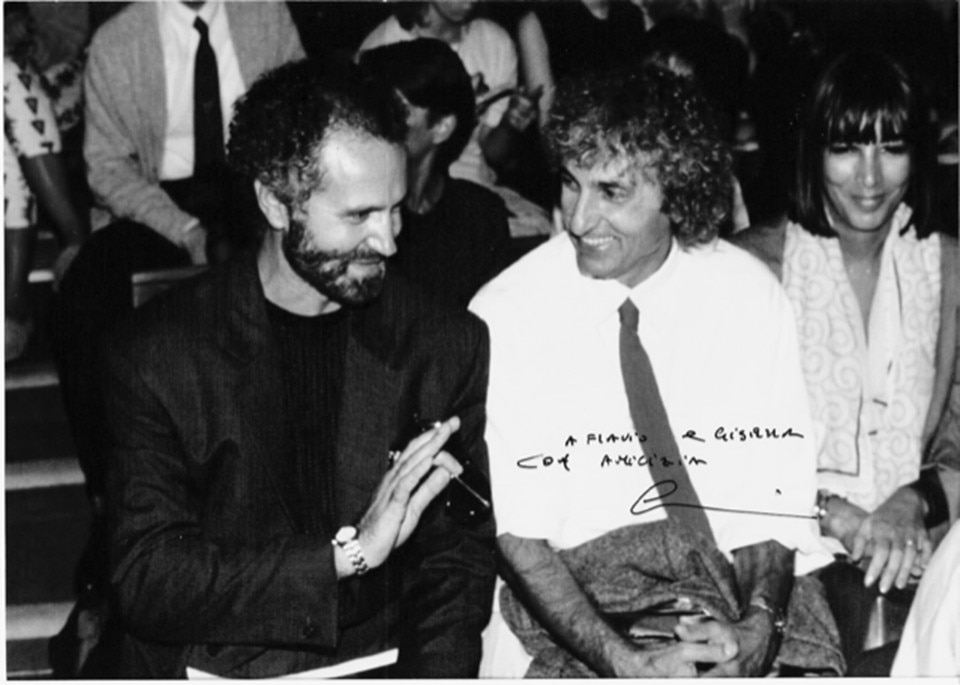
Some portraits of Flavio Lucchini
Flavio Lucchini has collaborated and met many artists. From Ernesto Rogers to Bruno Munari, from Giorgio Armani to Kenzo, from Andy Warhol to Man Ray, from Ettore Sottsass to Elio Fiorucci and many others.Flavio Lucchini ha collaborato e conosciuto moltissimi artisti. Da Ernesto Rogers a Bruno Munari, da Giorgio Armani a Kenzo, da Andy Warhol a Man Ray, da Ettore Sottsass a Elio Fiorucci e tantissimi altri.
Flavio Lucchini with Gianni Versace.
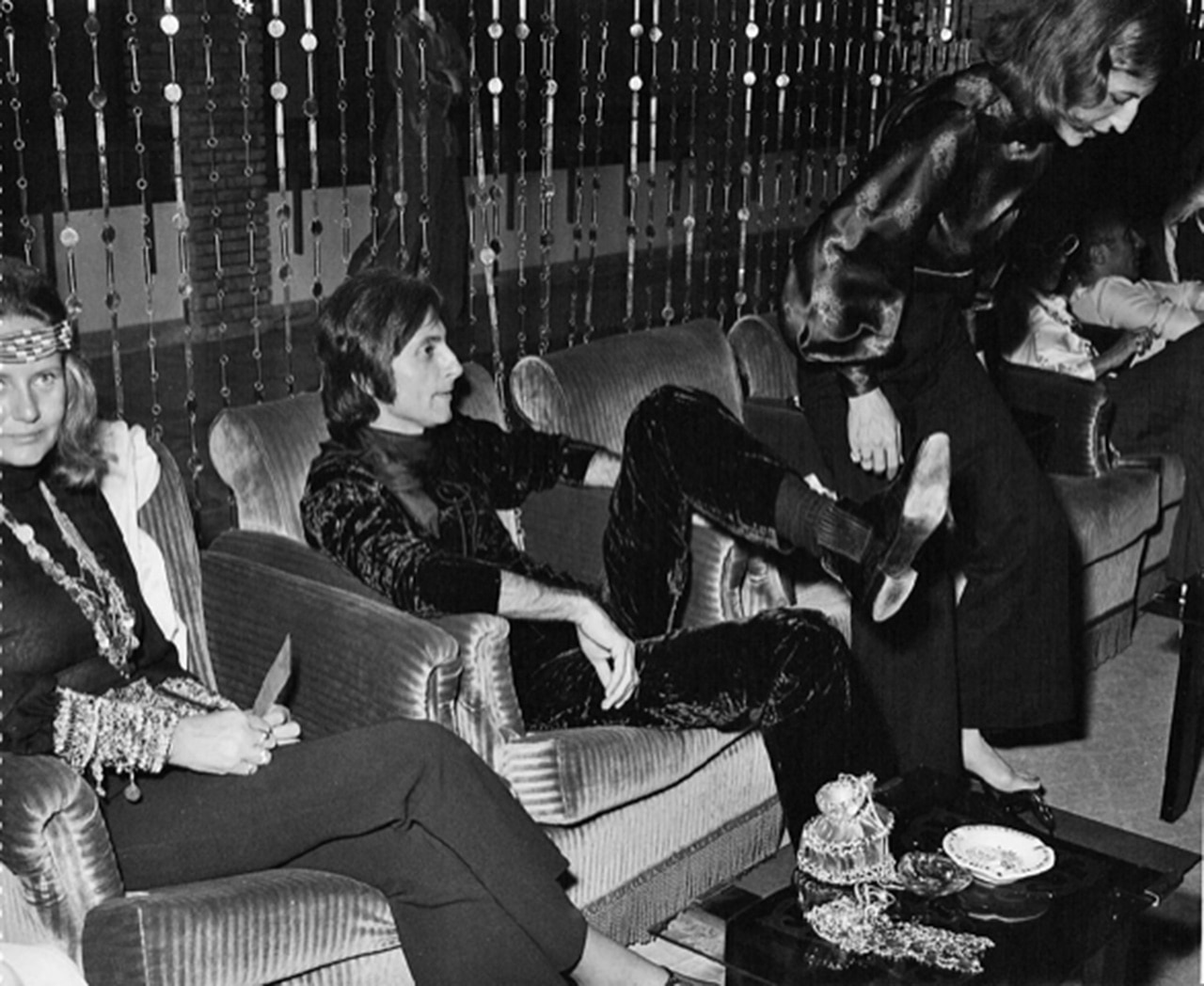
Some portraits of Flavio Lucchini
Flavio Lucchini has collaborated and met many artists. From Ernesto Rogers to Bruno Munari, from Giorgio Armani to Kenzo, from Andy Warhol to Man Ray, from Ettore Sottsass to Elio Fiorucci and many others.Flavio Lucchini ha collaborato e conosciuto moltissimi artisti. Da Ernesto Rogers a Bruno Munari, da Giorgio Armani a Kenzo, da Andy Warhol a Man Ray, da Ettore Sottsass a Elio Fiorucci e tantissimi altri.
Flavio Lucchini during a Vogue event.
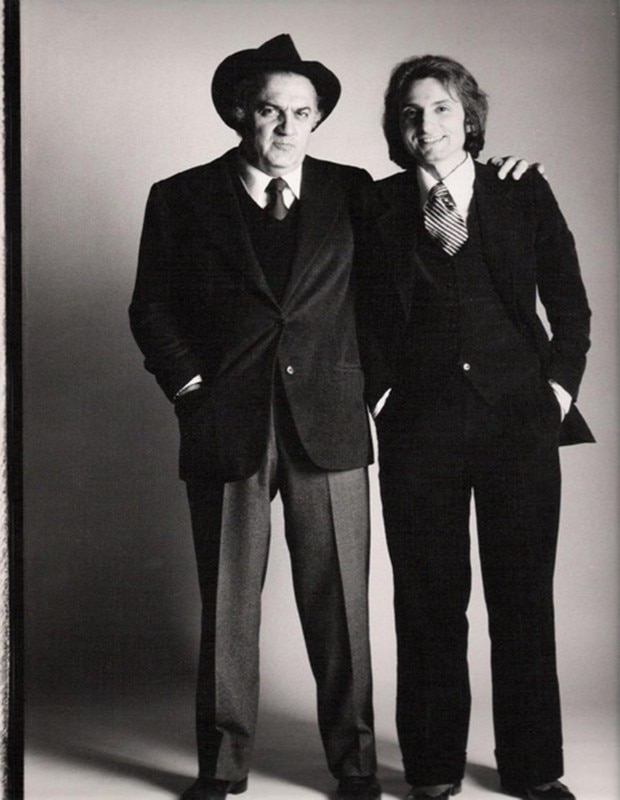
Some portraits of Flavio Lucchini
Flavio Lucchini has collaborated and met many artists. From Ernesto Rogers to Bruno Munari, from Giorgio Armani to Kenzo, from Andy Warhol to Man Ray, from Ettore Sottsass to Elio Fiorucci and many others.Flavio Lucchini ha collaborato e conosciuto moltissimi artisti. Da Ernesto Rogers a Bruno Munari, da Giorgio Armani a Kenzo, da Andy Warhol a Man Ray, da Ettore Sottsass a Elio Fiorucci e tantissimi altri.
Flavio Lucchini with the italian director Fellini.
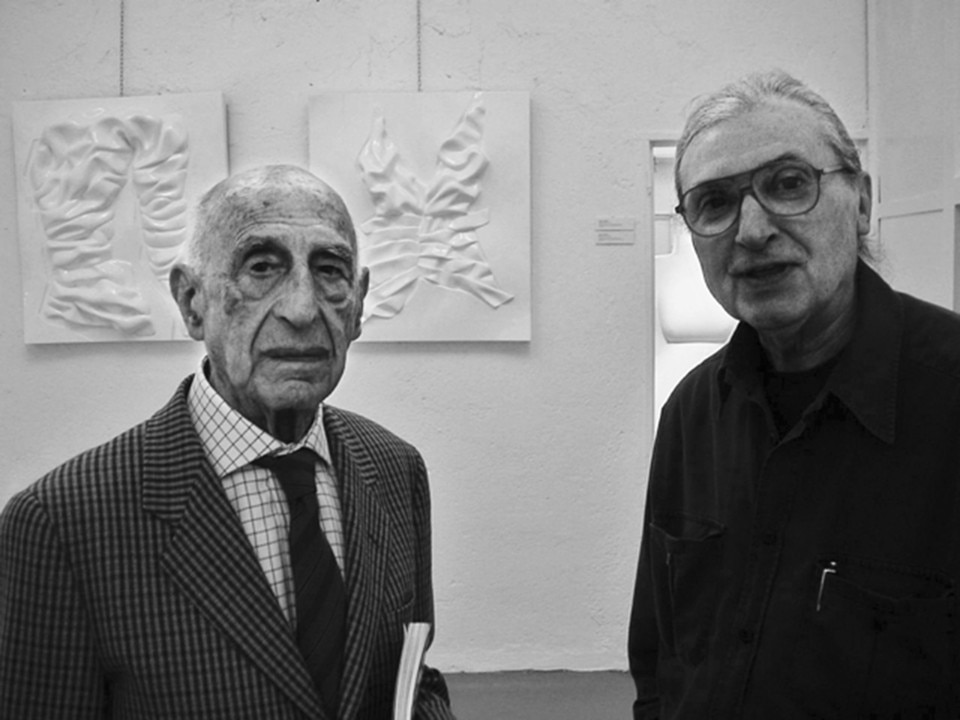
Some portraits of Flavio Lucchini
Flavio Lucchini has collaborated and met many artists. From Ernesto Rogers to Bruno Munari, from Giorgio Armani to Kenzo, from Andy Warhol to Man Ray, from Ettore Sottsass to Elio Fiorucci and many others.Flavio Lucchini ha collaborato e conosciuto moltissimi artisti. Da Ernesto Rogers a Bruno Munari, da Giorgio Armani a Kenzo, da Andy Warhol a Man Ray, da Ettore Sottsass a Elio Fiorucci e tantissimi altri.
Flavio Lucchini with Gillo Dorfles.
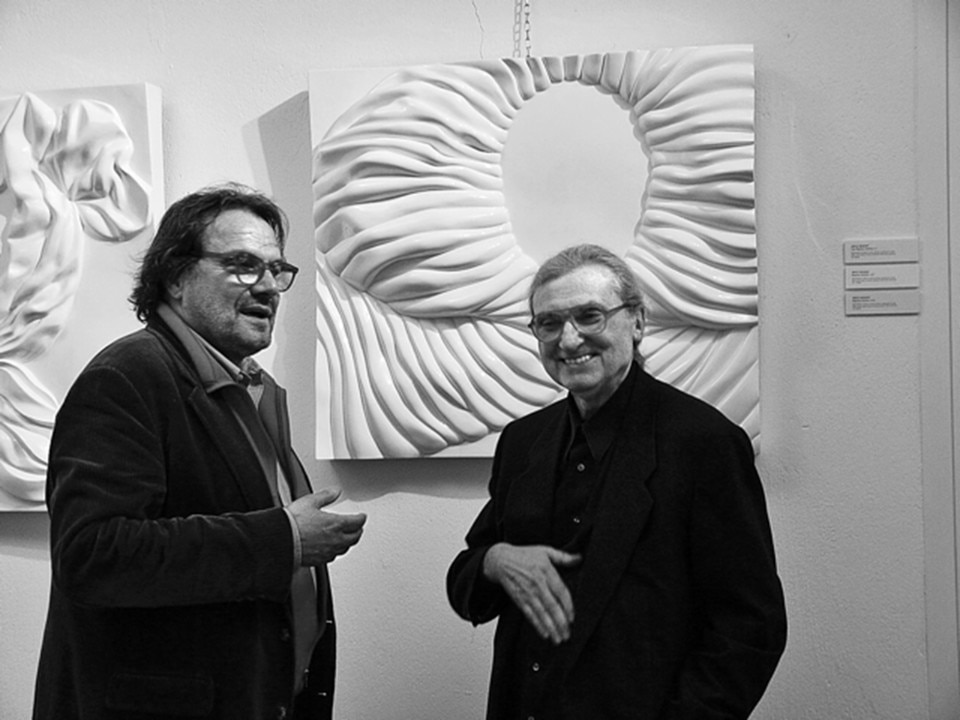
Some portraits of Flavio Lucchini
Flavio Lucchini has collaborated and met many artists. From Ernesto Rogers to Bruno Munari, from Giorgio Armani to Kenzo, from Andy Warhol to Man Ray, from Ettore Sottsass to Elio Fiorucci and many others.Flavio Lucchini ha collaborato e conosciuto moltissimi artisti. Da Ernesto Rogers a Bruno Munari, da Giorgio Armani a Kenzo, da Andy Warhol a Man Ray, da Ettore Sottsass a Elio Fiorucci e tantissimi altri.
Flavio Lucchini with Oliviero Toscani.
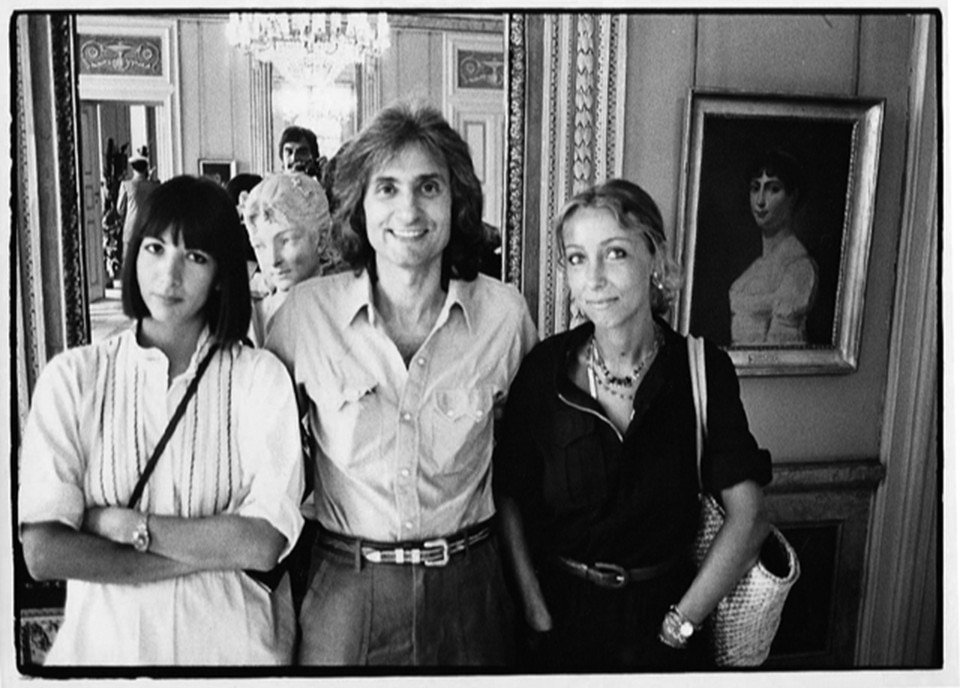
Some portraits of Flavio Lucchini
Flavio Lucchini has collaborated and met many artists. From Ernesto Rogers to Bruno Munari, from Giorgio Armani to Kenzo, from Andy Warhol to Man Ray, from Ettore Sottsass to Elio Fiorucci and many others.Flavio Lucchini ha collaborato e conosciuto moltissimi artisti. Da Ernesto Rogers a Bruno Munari, da Giorgio Armani a Kenzo, da Andy Warhol a Man Ray, da Ettore Sottsass a Elio Fiorucci e tantissimi altri.
Lucchini's marriage
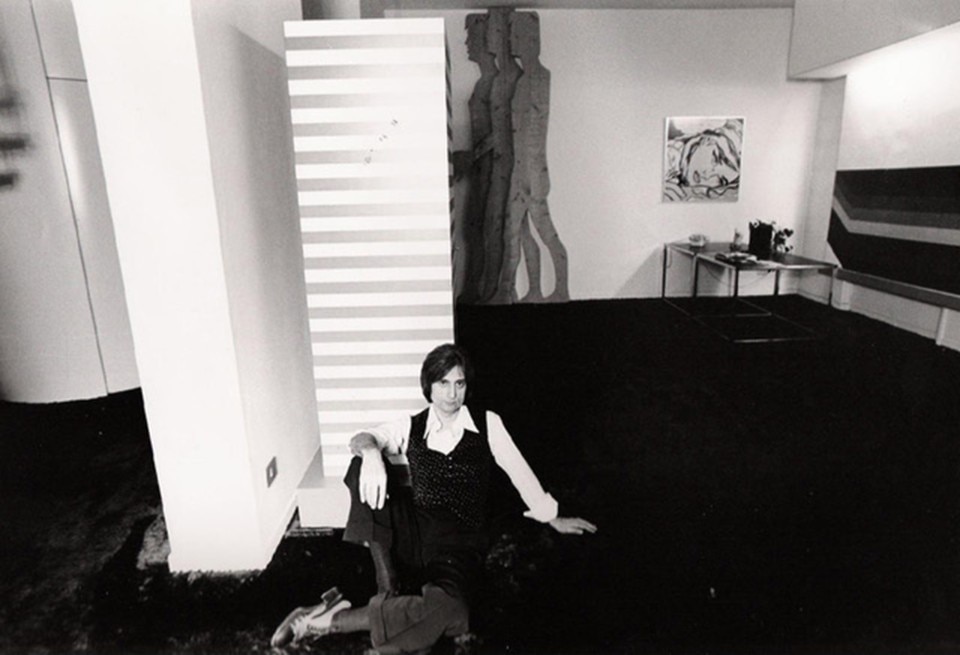
Some portraits of Flavio Lucchini
Flavio Lucchini has collaborated and met many artists. From Ernesto Rogers to Bruno Munari, from Giorgio Armani to Kenzo, from Andy Warhol to Man Ray, from Ettore Sottsass to Elio Fiorucci and many others.Flavio Lucchini ha collaborato e conosciuto moltissimi artisti. Da Ernesto Rogers a Bruno Munari, da Giorgio Armani a Kenzo, da Andy Warhol a Man Ray, da Ettore Sottsass a Elio Fiorucci e tantissimi altri.
Flavio Lucchini at home.

Some portraits of Flavio Lucchini
Flavio Lucchini has collaborated and met many artists. From Ernesto Rogers to Bruno Munari, from Giorgio Armani to Kenzo, from Andy Warhol to Man Ray, from Ettore Sottsass to Elio Fiorucci and many others.Flavio Lucchini ha collaborato e conosciuto moltissimi artisti. Da Ernesto Rogers a Bruno Munari, da Giorgio Armani a Kenzo, da Andy Warhol a Man Ray, da Ettore Sottsass a Elio Fiorucci e tantissimi altri.
Flavio Lucchini with Gianni Versace.

Some portraits of Flavio Lucchini
Flavio Lucchini has collaborated and met many artists. From Ernesto Rogers to Bruno Munari, from Giorgio Armani to Kenzo, from Andy Warhol to Man Ray, from Ettore Sottsass to Elio Fiorucci and many others.Flavio Lucchini ha collaborato e conosciuto moltissimi artisti. Da Ernesto Rogers a Bruno Munari, da Giorgio Armani a Kenzo, da Andy Warhol a Man Ray, da Ettore Sottsass a Elio Fiorucci e tantissimi altri.
Flavio Lucchini during a Vogue event.

Some portraits of Flavio Lucchini
Flavio Lucchini has collaborated and met many artists. From Ernesto Rogers to Bruno Munari, from Giorgio Armani to Kenzo, from Andy Warhol to Man Ray, from Ettore Sottsass to Elio Fiorucci and many others.Flavio Lucchini ha collaborato e conosciuto moltissimi artisti. Da Ernesto Rogers a Bruno Munari, da Giorgio Armani a Kenzo, da Andy Warhol a Man Ray, da Ettore Sottsass a Elio Fiorucci e tantissimi altri.
Flavio Lucchini with the italian director Fellini.

Some portraits of Flavio Lucchini
Flavio Lucchini has collaborated and met many artists. From Ernesto Rogers to Bruno Munari, from Giorgio Armani to Kenzo, from Andy Warhol to Man Ray, from Ettore Sottsass to Elio Fiorucci and many others.Flavio Lucchini ha collaborato e conosciuto moltissimi artisti. Da Ernesto Rogers a Bruno Munari, da Giorgio Armani a Kenzo, da Andy Warhol a Man Ray, da Ettore Sottsass a Elio Fiorucci e tantissimi altri.
Flavio Lucchini with Gillo Dorfles.

Some portraits of Flavio Lucchini
Flavio Lucchini has collaborated and met many artists. From Ernesto Rogers to Bruno Munari, from Giorgio Armani to Kenzo, from Andy Warhol to Man Ray, from Ettore Sottsass to Elio Fiorucci and many others.Flavio Lucchini ha collaborato e conosciuto moltissimi artisti. Da Ernesto Rogers a Bruno Munari, da Giorgio Armani a Kenzo, da Andy Warhol a Man Ray, da Ettore Sottsass a Elio Fiorucci e tantissimi altri.
Flavio Lucchini with Oliviero Toscani.

Some portraits of Flavio Lucchini
Flavio Lucchini has collaborated and met many artists. From Ernesto Rogers to Bruno Munari, from Giorgio Armani to Kenzo, from Andy Warhol to Man Ray, from Ettore Sottsass to Elio Fiorucci and many others.Flavio Lucchini ha collaborato e conosciuto moltissimi artisti. Da Ernesto Rogers a Bruno Munari, da Giorgio Armani a Kenzo, da Andy Warhol a Man Ray, da Ettore Sottsass a Elio Fiorucci e tantissimi altri.
Lucchini's marriage

Some portraits of Flavio Lucchini
Flavio Lucchini has collaborated and met many artists. From Ernesto Rogers to Bruno Munari, from Giorgio Armani to Kenzo, from Andy Warhol to Man Ray, from Ettore Sottsass to Elio Fiorucci and many others.Flavio Lucchini ha collaborato e conosciuto moltissimi artisti. Da Ernesto Rogers a Bruno Munari, da Giorgio Armani a Kenzo, da Andy Warhol a Man Ray, da Ettore Sottsass a Elio Fiorucci e tantissimi altri.
Flavio Lucchini at home.
In 1983, you founded Superstudio 13, the first centre for photography and the image. Then, in 2000, you started Superstudio Più, specialising in fashion, art, design and communication. How do you see the increasingly close bonds between these fields?
I’ve always seen fashion as important, as an inspiration and as a reflection of changes in society and around the world. In 1983, I thought of opening, with Fabrizio Ferri, a centre for photography studios and services with all the new technologies that fashion photography needed. Staying up to date technically had become necessary because progress in photography was rapid and expensive. Then I decided to get out of paper-based publishing because I thought that the internet would soon throw everyone into crisis. In 2000 my love of fashion, design, art and communication led me to open a large centre for events connected to my professional experience. Superstudio Più aimed to be an “advanced” communication service and to help young talent and emerging artists get noticed.
Who have been the most interesting people you’ve known?
There have been so many. Ernesto Rogers, Bruno Munari, Giorgio Armani, Kenzo, Andy Warhol, Man Ray, Ettore Sottsass and Elio Fiorucci – and many, many others.
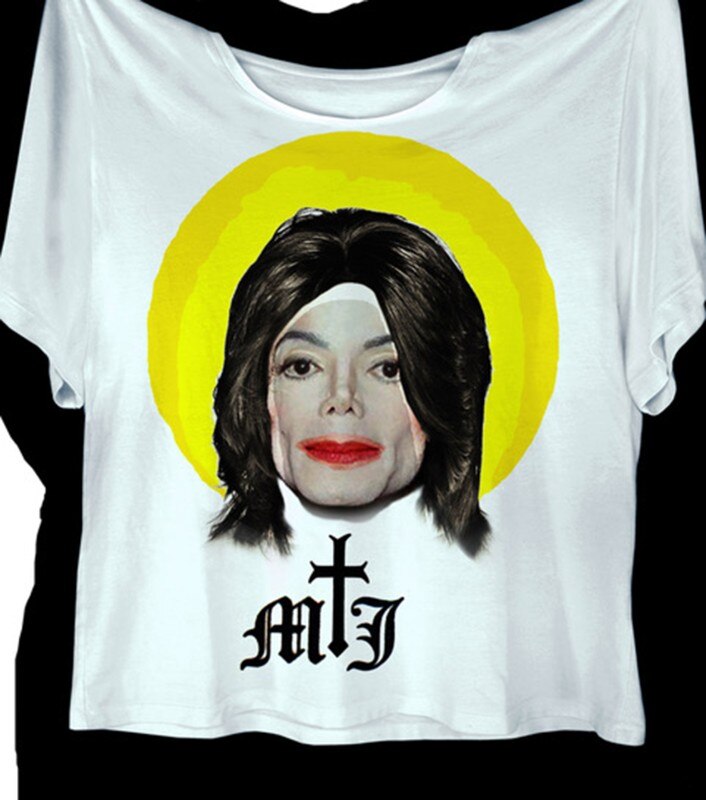
When you ran L’Uomo Vogue, you managed to convince Yves Saint Laurent and Andy Warhol to pose for a fashion shoot…
I met and photographed Andy Warhol with Oliviero Toscani. It was fun because while we were shooting him, he was taking Polaroids of us. At that time, Gerry Malanga, who was of Italian descent, was working as his assistant. For our second visit with Clino Castelli, he organised a round of marijuana, with everyone sitting in a circle to greet us. That was a surprise for me. It was still rare in Italy then [smiles]. When Saint Laurent presented his first men’s fashion collection, I thought L’Uomo Voguewas the best way of getting it known and he agreed to model it himself. He was already a giant. I’ll always remember the atmosphere of that meeting. Before going onto the set, he asked me: “ça va comme ça Flaviò?” He was young, like us – and like us, he was full of enthusiasm. It all seemed like a game to us.
As an artist, what feeds your creativity?
I no longer work in a studio but I still observe the world. I read history and architecture books, and fashion magazines. I watch fashion shows on my iPad, plunge frequently into the ferment of Dubai, write, draw, and create logos and graphic designs to support the work of Superstudio – or small sculptures for charity initiatives when asked.
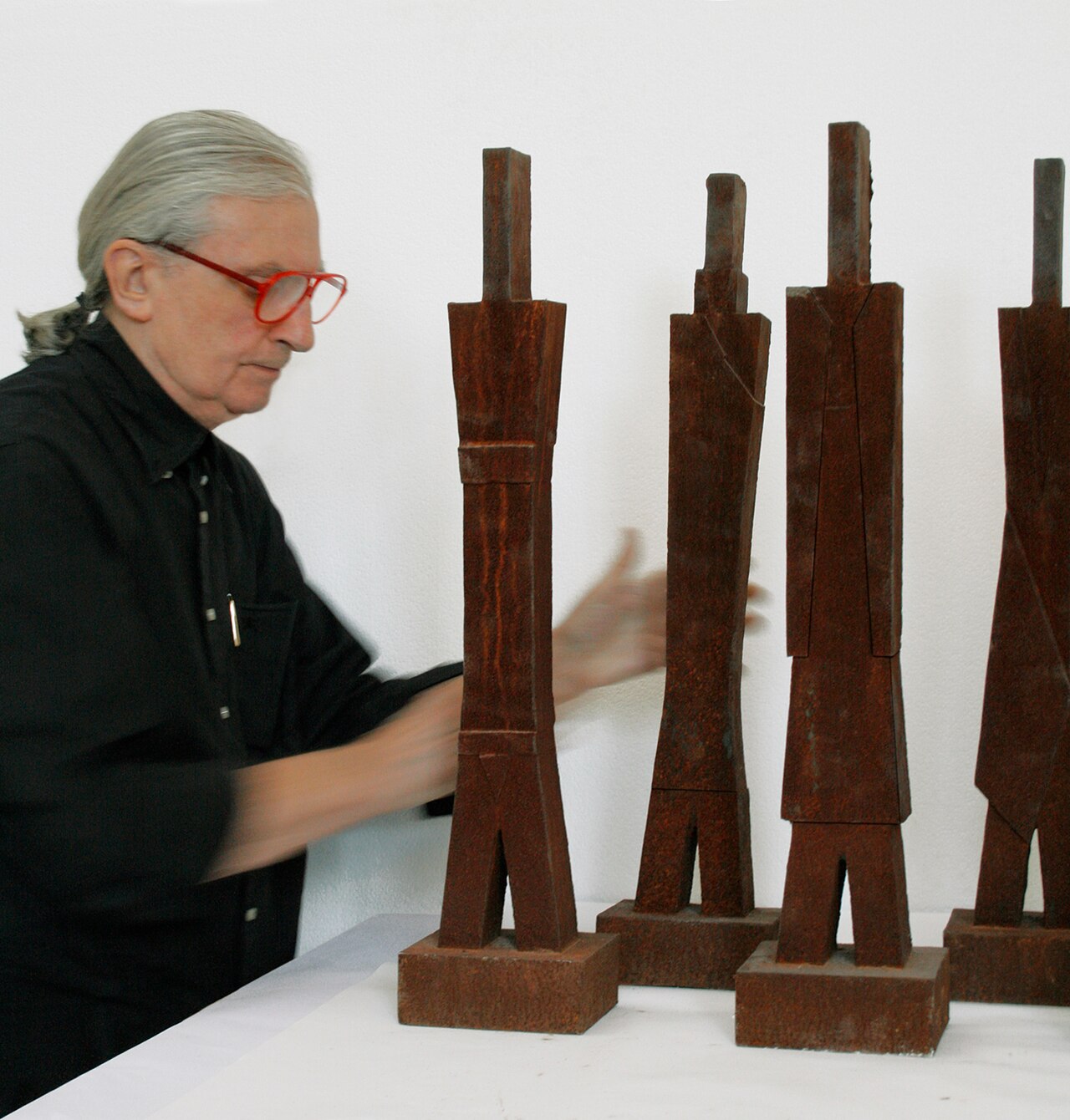
 View gallery
View gallery
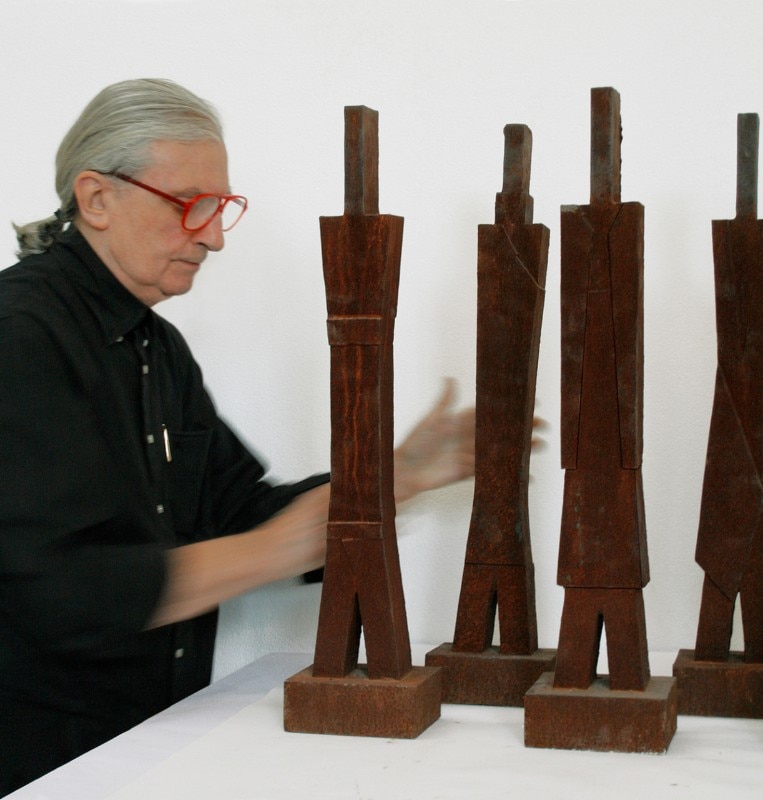
Dress-totem: the dress becomes divinity
Flavio Lucchini has tried, for years, to transform the dress photographed by the great fashion magazines into an object-idol, making it an urban totem. Some of the works have been made in large dimensions while others have remained in maquette format.
Dress-Totem. Single and multiple figures. Rusty iron.
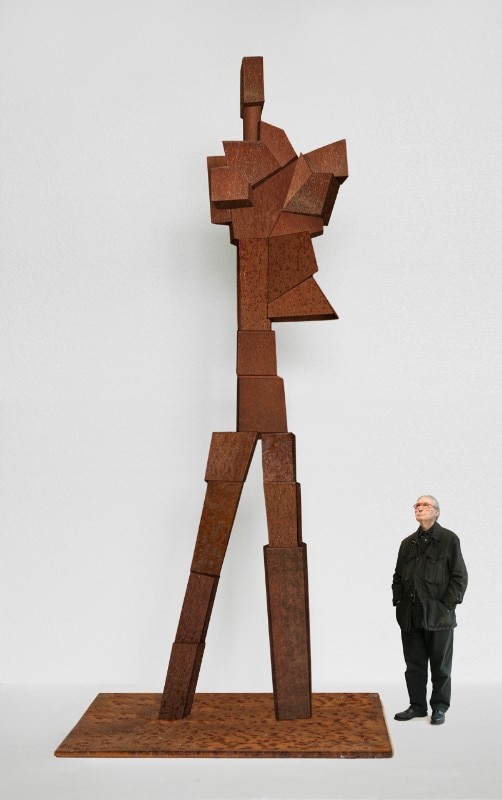
Dress-totem: the dress becomes divinity
Flavio Lucchini has tried, for years, to transform the dress photographed by the great fashion magazines into an object-idol, making it an urban totem. Some of the works have been made in large dimensions while others have remained in maquette format.
Dress Totem, natural cor-ten steel sculpture.
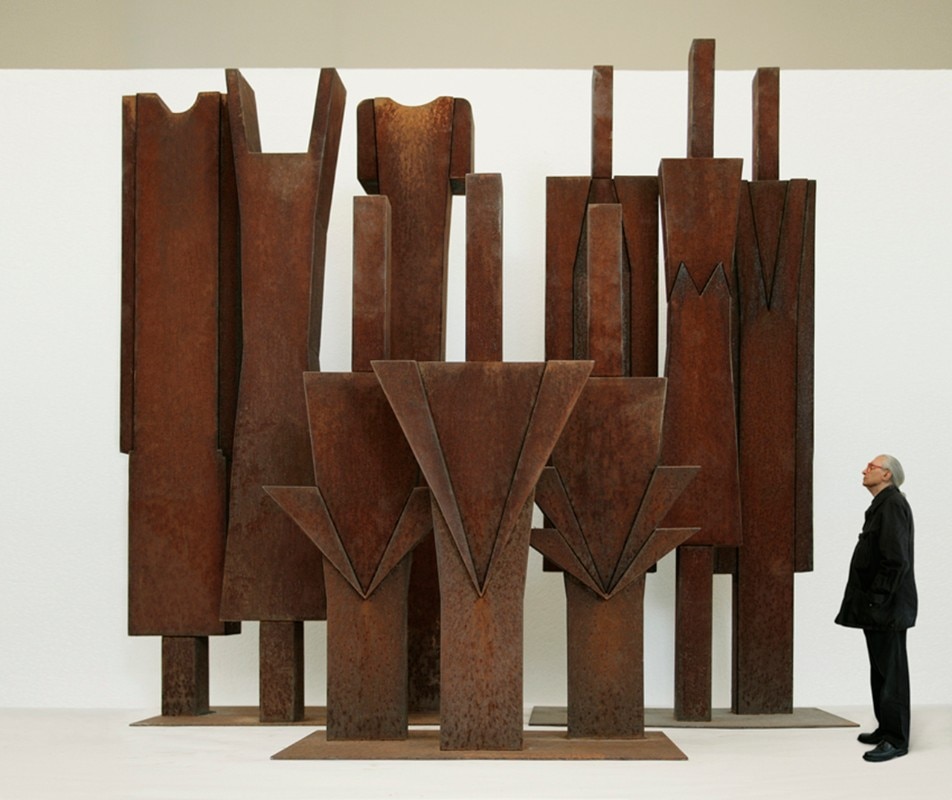
Dress-totem: the dress becomes divinity
Flavio Lucchini has tried, for years, to transform the dress photographed by the great fashion magazines into an object-idol, making it an urban totem. Some of the works have been made in large dimensions while others have remained in maquette format.
Dress-Totem. Rusty iron group.
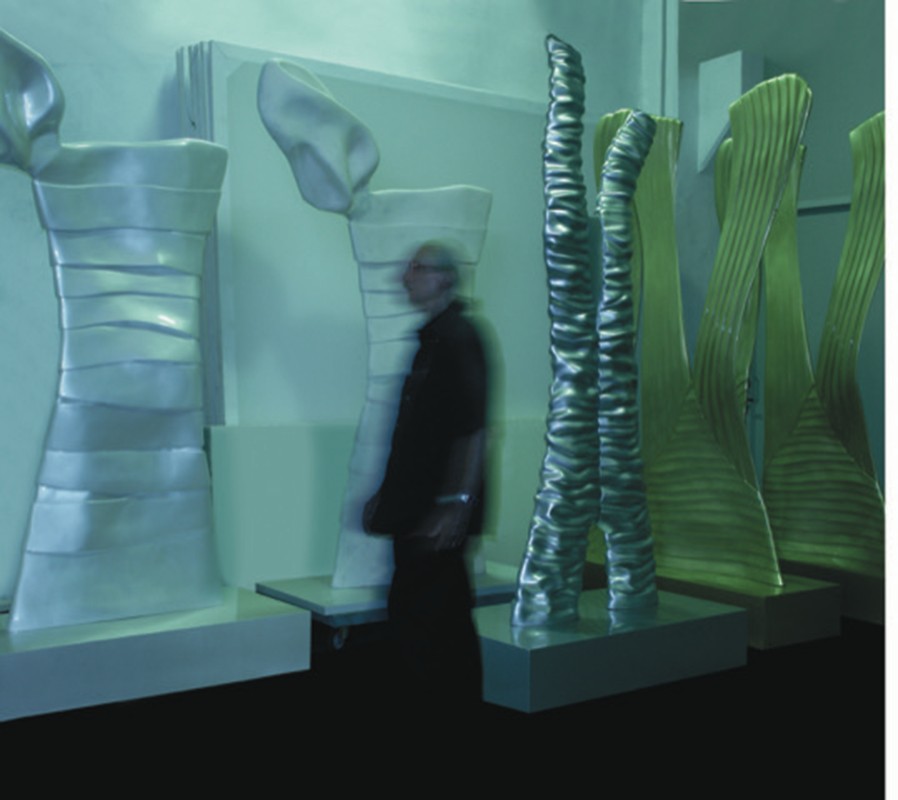
Dress-totem: the dress becomes divinity
Flavio Lucchini has tried, for years, to transform the dress photographed by the great fashion magazines into an object-idol, making it an urban totem. Some of the works have been made in large dimensions while others have remained in maquette format.
Flavio Lucchini with his Ghosts.
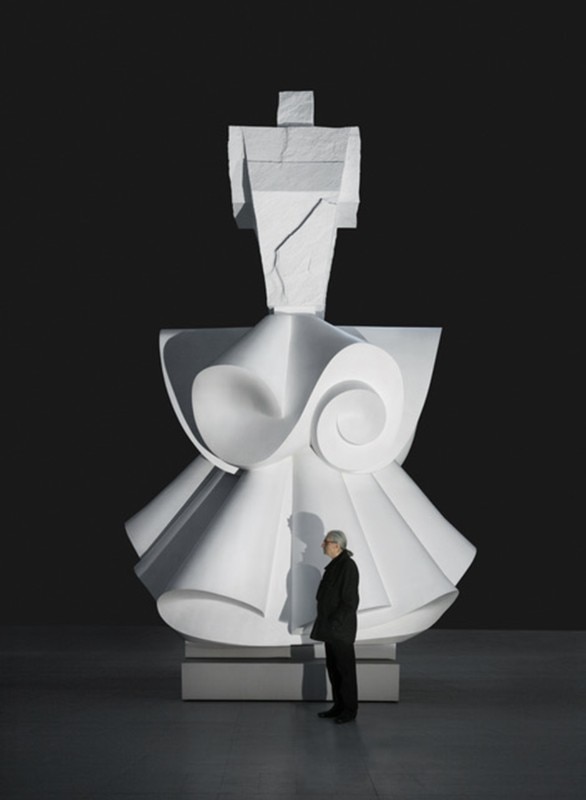
Dress-totem: the dress becomes divinity
Flavio Lucchini has tried, for years, to transform the dress photographed by the great fashion magazines into an object-idol, making it an urban totem. Some of the works have been made in large dimensions while others have remained in maquette format.
Flavio Lucchini and the White Totem, oversized clothes that emphasize the whole emotion of a dress.
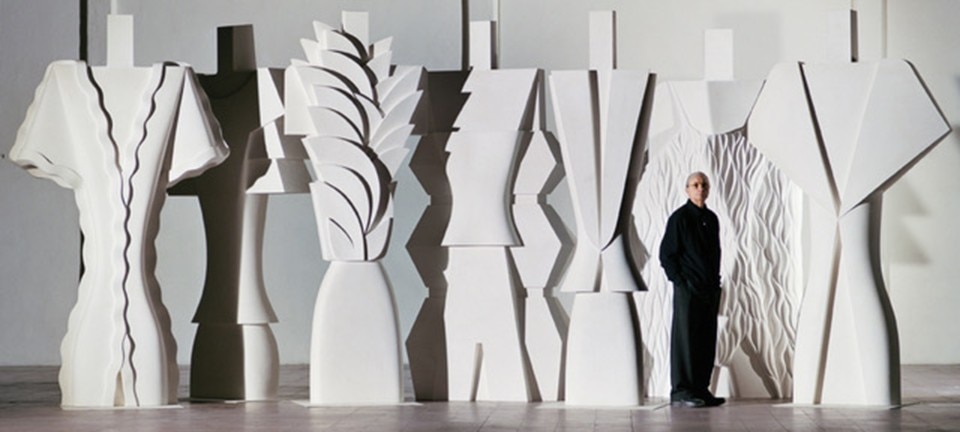
Dress-totem: the dress becomes divinity
Flavio Lucchini has tried, for years, to transform the dress photographed by the great fashion magazines into an object-idol, making it an urban totem. Some of the works have been made in large dimensions while others have remained in maquette format.
Flavio Lucchini and the White Totem, oversized clothes that emphasize the whole emotion of a dress.
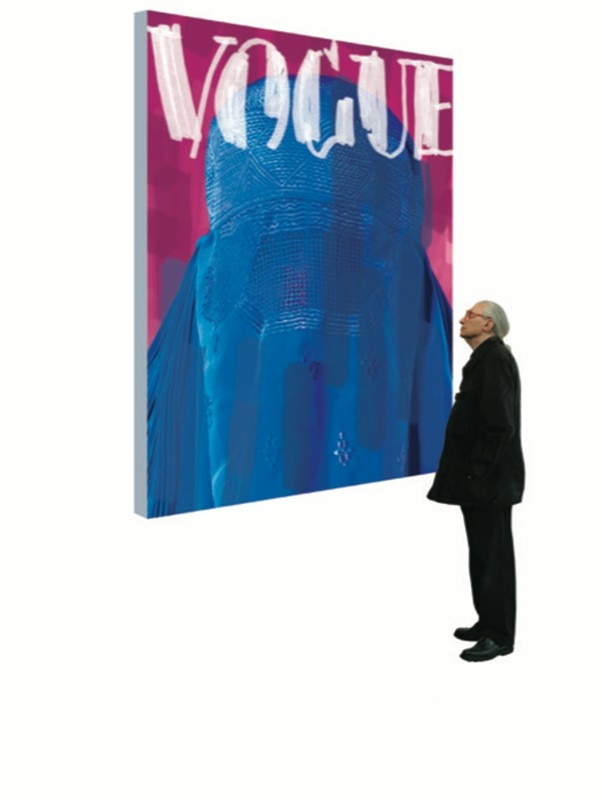
Dress-totem: the dress becomes divinity
Flavio Lucchini has tried, for years, to transform the dress photographed by the great fashion magazines into an object-idol, making it an urban totem. Some of the works have been made in large dimensions while others have remained in maquette format.
Flavio Lucchini, Cover/Vogue, digital print on canvas and graphic design, 2011.
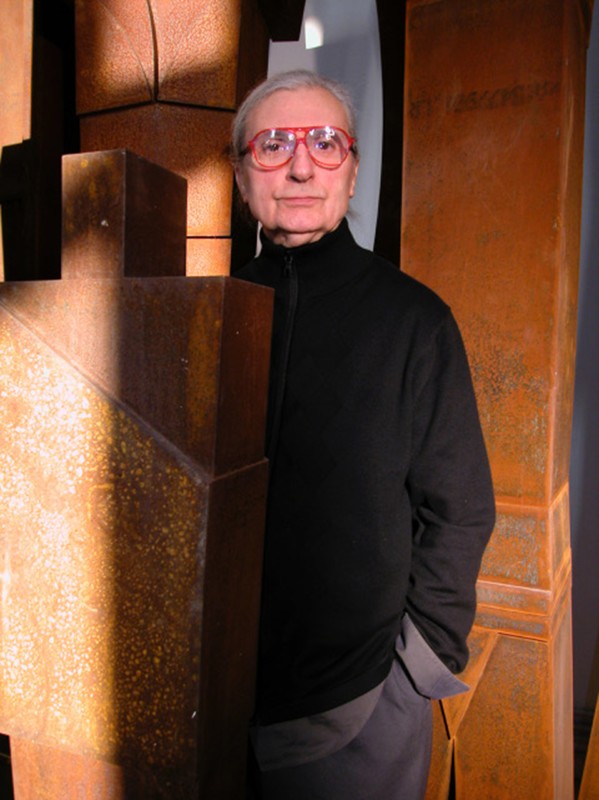
Dress-totem: the dress becomes divinity
Flavio Lucchini has tried, for years, to transform the dress photographed by the great fashion magazines into an object-idol, making it an urban totem. Some of the works have been made in large dimensions while others have remained in maquette format.
Flavio Lucchini. Portrait

Dress-totem: the dress becomes divinity
Flavio Lucchini has tried, for years, to transform the dress photographed by the great fashion magazines into an object-idol, making it an urban totem. Some of the works have been made in large dimensions while others have remained in maquette format.
Dress-Totem. Single and multiple figures. Rusty iron.

Dress-totem: the dress becomes divinity
Flavio Lucchini has tried, for years, to transform the dress photographed by the great fashion magazines into an object-idol, making it an urban totem. Some of the works have been made in large dimensions while others have remained in maquette format.
Dress Totem, natural cor-ten steel sculpture.

Dress-totem: the dress becomes divinity
Flavio Lucchini has tried, for years, to transform the dress photographed by the great fashion magazines into an object-idol, making it an urban totem. Some of the works have been made in large dimensions while others have remained in maquette format.
Dress-Totem. Rusty iron group.

Dress-totem: the dress becomes divinity
Flavio Lucchini has tried, for years, to transform the dress photographed by the great fashion magazines into an object-idol, making it an urban totem. Some of the works have been made in large dimensions while others have remained in maquette format.
Flavio Lucchini with his Ghosts.

Dress-totem: the dress becomes divinity
Flavio Lucchini has tried, for years, to transform the dress photographed by the great fashion magazines into an object-idol, making it an urban totem. Some of the works have been made in large dimensions while others have remained in maquette format.
Flavio Lucchini and the White Totem, oversized clothes that emphasize the whole emotion of a dress.

Dress-totem: the dress becomes divinity
Flavio Lucchini has tried, for years, to transform the dress photographed by the great fashion magazines into an object-idol, making it an urban totem. Some of the works have been made in large dimensions while others have remained in maquette format.
Flavio Lucchini and the White Totem, oversized clothes that emphasize the whole emotion of a dress.

Dress-totem: the dress becomes divinity
Flavio Lucchini has tried, for years, to transform the dress photographed by the great fashion magazines into an object-idol, making it an urban totem. Some of the works have been made in large dimensions while others have remained in maquette format.
Flavio Lucchini, Cover/Vogue, digital print on canvas and graphic design, 2011.

Dress-totem: the dress becomes divinity
Flavio Lucchini has tried, for years, to transform the dress photographed by the great fashion magazines into an object-idol, making it an urban totem. Some of the works have been made in large dimensions while others have remained in maquette format.
Flavio Lucchini. Portrait
Who are your favourite artists?
The artist who I feel is closest to my way of thinking in art is Andy Warhol. That’s partly because of his career – he started as a graphic designer and then with Campbell’s Soup Canscreated an icon. It’s also because for him everything could become art – even a good deal. As he famously said: “Good business is the best art.”
You’re now a young man of 90. Thinking of the future, what would you like to pass on to the next generation of designers, creatives and entrepreneurs?To young entrepreneurs, to creatives in every field, I would like to say: believe strongly in your ideas and your ability. Love your choices and your work will make you happy. Be passionate. Put all your energy into reaching your goals. You can do it.
- Exhibition:
- "Ricomincio dai 90"
- Curated by:
- Gisella Borioli
- Opening dates:
- January/December 2018
- Venue:
- MyOwnGallery
- Address:
- Via Tortona 27, Milan
- Exhibition:
- Ghost by Flavio Lucchini
- Curated by:
- Superstudio Group
- In collaboration with:
- MyOwnGallery
- Opening dates:
- 27th October - 30th November 2018
- Venue:
- La Triennale di Milano
- Address:
- Palazzo della Triennale, Viale Alemagna 6, Milano


